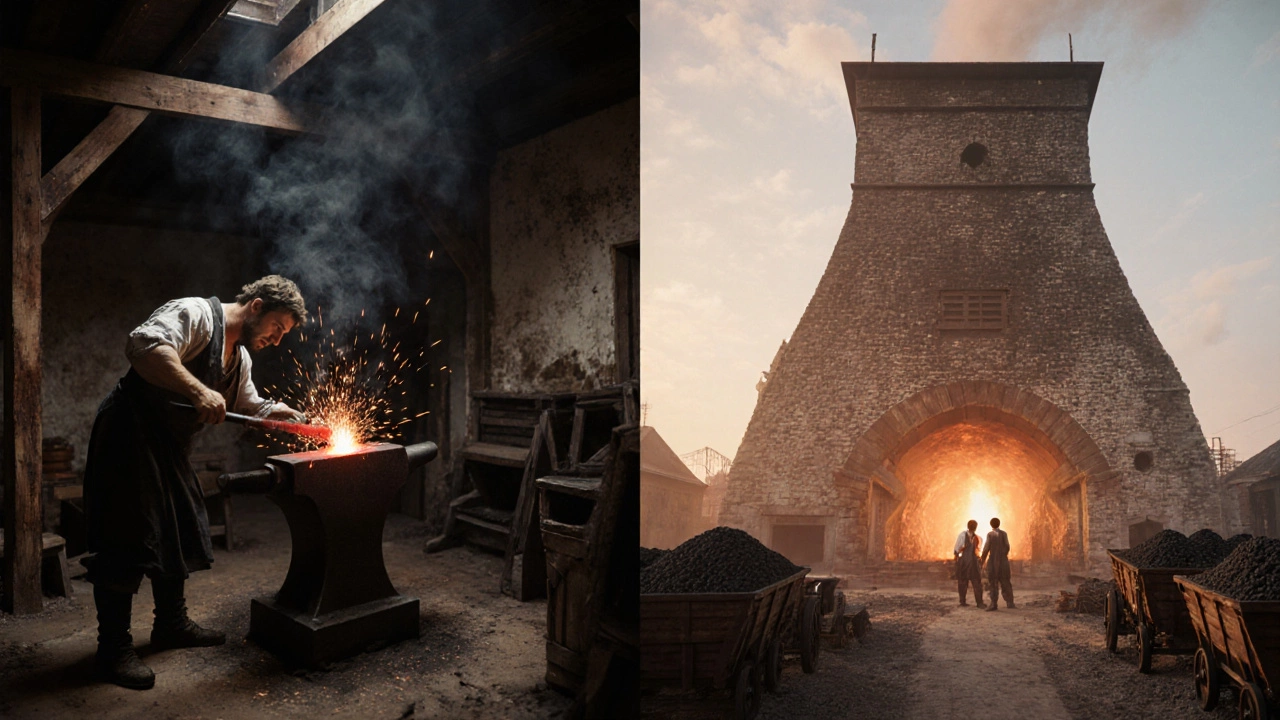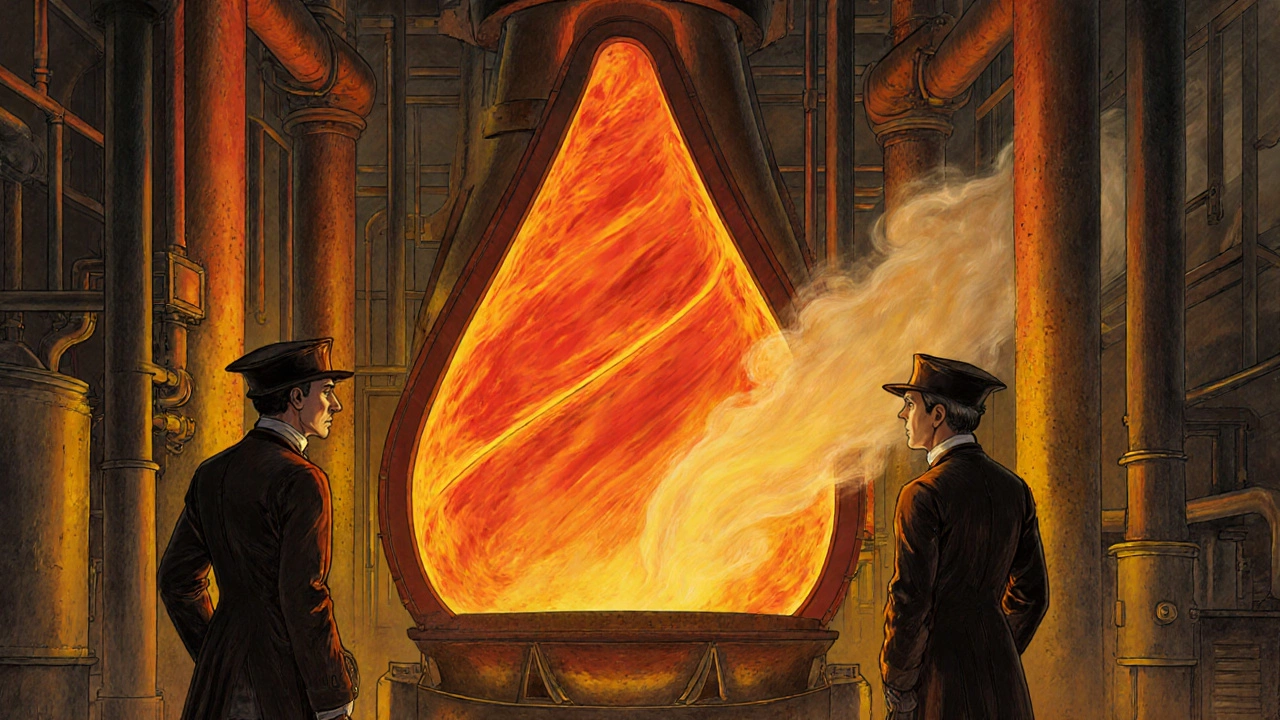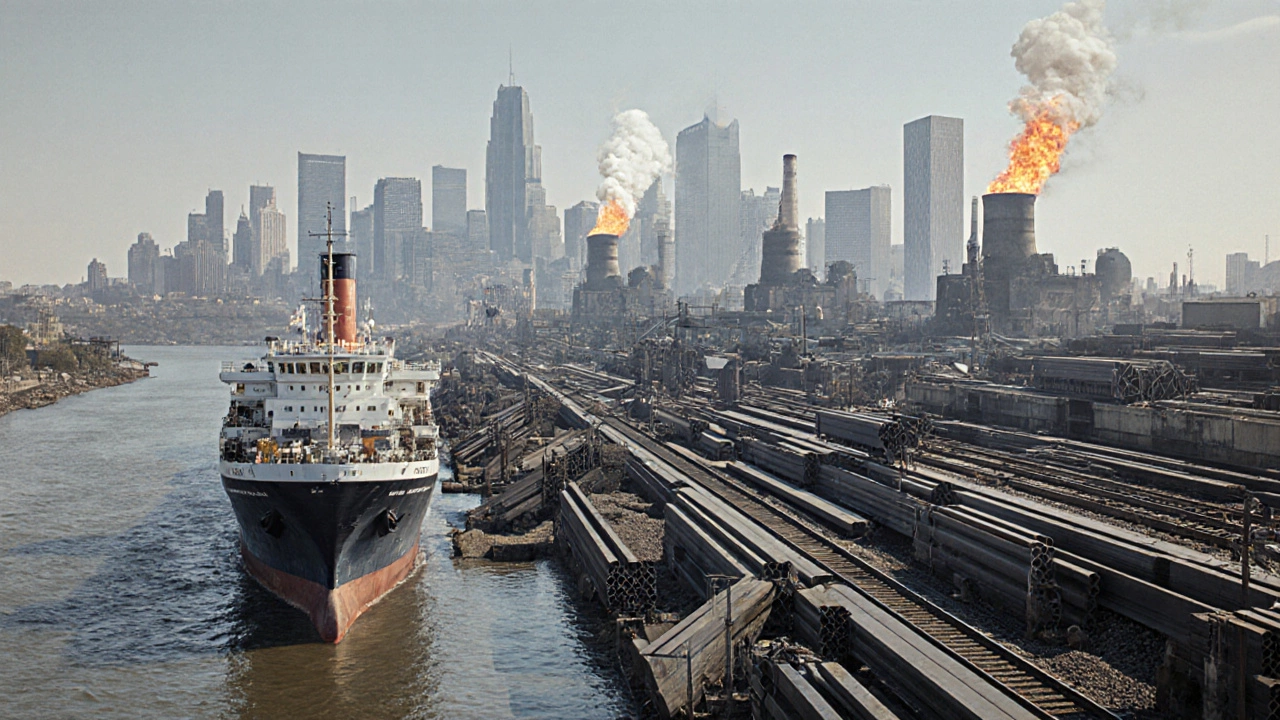
Steel Industry Founder Comparison Tool
Who Really Built the Steel Industry?
Select a comparison category to see how Henry Bessemer and Andrew Carnegie differed in their contributions to steel production.
Inventor of the Modern Steel Process
English engineer who developed the first practical method for mass-producing steel in the 1850s.
Key Contribution: The Bessemer process revolutionized steel production by allowing large-scale, affordable steel manufacturing.
Industrial Titan of American Steel
Scottish-American entrepreneur who built the world's largest steel empire through vertical integration and business innovation.
Key Contribution: Created the first vertically integrated steel company that controlled all aspects of production from ore to finished goods.
Comparison Results
When you select a comparison category, the results will appear here.
Why This Matters
Understanding the distinct contributions of Bessemer and Carnegie helps clarify why both are considered foundational to the steel industry. Bessemer provided the technological breakthrough, while Carnegie created the industrial model that made steel affordable and widely available.
When you hear the phrase father of steel industry, two names usually pop up: a British inventor who turned iron into cheap steel, and an American magnate who built an empire around it. This article untangles who truly earned that title, why their contributions matter today, and how the steel world looks because of them.
Key Takeaways
- Henry Bessemer invented the first commercial steel‑making process in the 1850s, earning him the nickname “father of modern steel.”
- Andrew Carnegie transformed the United States into a steel powerhouse in the late 19thcentury, often called “the father of the American steel industry.”
- Both men relied on the blast furnace and rolling mill, but Bessemer’s process was a technological breakthrough while Carnegie’s success was built on scale, vertical integration, and finance.
- Their legacies live on in today’s global steel supply chain, from skyscrapers to cars.
Early Roots of the Steel Business
Before the mid‑1800s, steel was a luxury. Blacksmiths produced small batches by repeatedly heating and hammering iron, a labor‑intensive method that limited output. The industrial revolution introduced the blast furnace, which could smelt iron ore into molten pig iron at scale, but that pig iron was still brittle.
Enter two innovators who saw the same problem from opposite sides of the globe and solved it in very different ways.
Henry Bessemer - The British Innovator
In 1855, Henry Bessemer an English engineer and iron‑monger who patented the first inexpensive mass‑production method for steel introduced the Bessemer process. By blowing air through molten pig iron, the process oxidized excess carbon, turning the iron into steel in under an hour.
The brilliance of the Bessemer process lay in three simple principles:
- Air injection rapidly removes carbon and impurities.
- The exothermic reactions generate enough heat to keep the metal molten without external fuel.
- Large‑scale converters can treat a ton of iron in a single batch.
Within a decade, Bessemer converters were sprouting across the United Kingdom the birthplace of the industrial revolution and early adopter of Bessemer steel, and the technology quickly spread to Europe and the United States.
Andrew Carnegie - The American Titan
Meanwhile, across the Atlantic, a 30‑year‑old Scottish immigrant named Andrew Carnegie an American steel magnate who built Carnegie Steel Company into the world’s largest steel producer by 1900 was watching Bessemer’s breakthrough with keen interest.
Carnegie’s genius wasn’t a new process; it was a business model. He combined several elements into a vertically integrated empire:
- Ownership of raw‑material mines (iron ore in the Lake Superior region).
- Control of every transportation link (railroads, lake‑shipping fleets).
- Investment in state‑of‑the‑art blast furnaces and rolling mills powered by the Bessemer process.
- Aggressive cost‑cutting and relentless focus on productivity.
By 1892, Carnegie Steel Company the dominant US steelmaker that produced over a third of the nation’s steel output could meet the soaring demand of railroads, skyscrapers, and shipbuilding. In 1901, J.P.Morgan bought Carnegie’s empire for $480million, forming U.S.Steel, a behemoth that still dominates the market today.

Comparing Their Impacts
| Aspect | Henry Bessemer | Andrew Carnegie |
|---|---|---|
| Primary Role | Inventor of the first commercial steel‑making process | Industrialist who built the largest steel enterprise |
| Core Innovation | Bessemer process (air‑blown converter) | Vertical integration of mines, transport, and mills |
| Region of Influence | United Kingdom, later Europe & USA | United States, especially the Northeast and Midwest |
| Era of Peak Impact | 1850s‑1870s | 1880s‑1900s |
| Legacy | Foundation of modern steelmaking | Model for large‑scale industrial organization |
How Their Contributions Shape Today’s Steel Industry
Modern steelmaking still relies on the principles Bessemer introduced-rapid oxidation of carbon, heat recycling, and converter‑type reactors. While the original Bessemer converter has been superseded by basic oxygen furnaces (BOF) and electric arc furnaces (EAF), the core chemistry is the same.
Carnegie’s vertical integration model lives on in today’s mega‑corporations that control everything from raw ore contracts to finished sheet steel. Companies such as ArcelorMittal and Nucor echo Carnegie’s strategy by owning mines, transport assets, and recycling facilities.
Both legacies also influence sustainability goals. The blast furnace, first perfected in the 19thcentury, now incorporates hydrogen injection and carbon‑capture technologies to cut emissions-an evolution of Bessemer’s quest for efficiency. Meanwhile, Carnegie’s focus on scale and cost reduction drives investment in large‑capacity, low‑carbon steel plants.
Common Misconceptions
People sometimes conflate “father of steel” with “father of the steel industry.” The former usually points to Bessemer for his technical breakthrough; the latter often honors Carnegie for building an entire economic sector around steel.
Another myth is that the Bessemer process made steel cheap overnight. In reality, it required high‑quality pig iron and skilled operators. The real cost drop happened when Carnegie combined the process with massive, low‑cost supply chains.

Quick Timeline
- 1855 - Henry Bessemer patents the air‑blown converter.
- 1865 - First Bessemer plants open in Sheffield, England.
- 1873 - Carnegie invests in a small steel mill in Pittsburgh.
- 1886 - Carnegie’s company builds the first large‑scale Bessemer plant in the UnitedStates.
- 1901 - J.P.Morgan purchases Carnegie Steel, forming U.S.Steel.
Legacy in Culture and Education
Both men appear in textbooks and museum exhibits. The Carnegie Museum of Natural History in Pittsburgh showcases his philanthropy, while the Science Museum in London features a full‑scale Bessemer converter for visitors.
Their stories also inspire modern entrepreneurs: a tech founder might see Bessemer’s rapid innovation as a model for disruptive products, while Carnegie’s emphasis on supply‑chain mastery resonates with CEOs scaling global operations.
Frequently Asked Questions
Was Henry Bessemer the first to produce steel?
No. Ancient civilizations produced small amounts of steel through crucible methods, but Bessemer created the first commercial, large‑scale process that made steel affordable for industry.
Why is Andrew Carnegie called the "father of the American steel industry"?
Because he built the UnitedStates' biggest steel producer, integrated every step from ore to finished rails, and set the template for modern industrial corporations.
Did the Bessemer process work everywhere?
It required pig iron low in phosphorus. Regions with high‑phosphorus ore had to adopt the later open‑hearth process until the basic oxygen furnace solved that problem.
What replaced the Bessemer converter?
The basic oxygen furnace, introduced in the 1940s, uses pure oxygen instead of air, yielding higher quality steel more efficiently.
Is Carnegie Steel still around?
Carnegie Steel became part of U.S.Steel in 1901. The brand name faded, but the facilities and many of its business practices live on in today’s major steel firms.